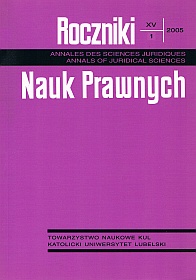The Supreme Court of the United States on the Turn of the 19th Century
Abstract
The end of 19th and the beginning of 20th century is a period of the most dynamic development in American history. In this period population of the USA growth three times, strongly developed American economy, and USA became a one of the world's superpowers.
All these happens in the period after the tragedy of Civil War and after the Reconstruction. Federal Supreme Court was an institution, which played crucial role in the overcame consequences of those years. The Court has have to rebuild trust for himself, which was not simple after the D. Scott case consequences. When it has happened, Court started with great energy shaping constitutional, social, economic and religious foundations of the Republic.
The great success of American progress in interesting period is also a great success of the Court, which stabilized law as a foundation of this development.
References
BarringerGordon S.: The Mormon Question: Polygamy and Constitutional Conflict in Nineteenth-Century America, „Journal of Supreme Court History”, 28(2003), No. 1.
Berger R.: Government by Judiciary: The Transformation of the Fourteenth Amandement, Cambridge 1977.
Bickel A. M.: The Original Understanding and Segregation Decisions, „Harvard Law Review” 69 (1955), No. 1.
Fairman Ch.: Does the Fourteenth Amandement Incorporate the Bill of Rights?, „Stanford Law Review”, 2(1949), No. 1.
Fairman Ch.: History of the Supreme Court of the United States: Reconstruction and Reunion 1864-1888, Part One, Cambridge 1971.
Górski G.: Sąd Najwyższy Stanów Zjednoczonych pod prezesurą Johna Marshalla (1801-1835), „Roczniki Nauk Prawnych”, 12 (2002), z. 1, s. 279-294.
Górski G.: Sąd Najwyższy w okresie Wojny Secesyjnej i Rekonstrukcji, „Roczniki Nauk Prawnych”, 14(2004), z. 1, s. 59-78.
Górski G.: Sprawa D. Scotta. Przyczynek do dziejów amerykańskiego konstytucjonalizmu, „Czasy Nowożytne” (Toruń), 13(2002).
Górski G.: Sprawa Marbury v. Madison z 1803 r. a kształtowanie się zasady sądownictwa konstytucyjnego, „Czasopismo Prawno-Historyczne” (Poznań), 52(2000).
Kelly A. H.: Clio and the Court: An Illicit K=Love Affair, „Supreme Court Review” (Chicago), 1965.
King W. L.: Melville Weston Fuller, Chief Justice of the United States 1888-1910, New York 1950.
Magrath C. P.: Morrison R. Waite: The Triumph of Character, New York 1963.
McLaughli n: A Constitutional History of the United States, 1935.
Posner R.: Economic Analysis of the Law, Chicago 1986.
Rhenquist W.: The Supreme Court. Revised and Updated, New York 2002.
Schwartz B.: A History of the Supreme Court, Oxford–New York.
Siegan B.: Rehabilitating Lochner, „San Diego Law Review”, 22(1985).
Tenbroek J.: Equal Justice under Law, New York 1965.
The Collected Works of Abraham Lincoln, Bassler Ed. 1953 – vol. 2.
The Supreme Court Justices, Washington 1995.
VanAlstyne W. W.: The Fourteenth Amendment, the „Right to Vote”, and the Understanding of the Thirty-Ninth Congress, „Supreme Court Review” (Chicago) 1966.
White R.: Information, Markets and Corruption: Transcontinental Railroads in the Gilded Age, „The Journal of American History”, 90 (2003), June, 1.
Zaremba P.: Historia Stanów Zjednoczonych, Londyn 1968.
Copyright (c) 2005 Roczniki Nauk Prawnych

This work is licensed under a Creative Commons Attribution-NonCommercial-NoDerivatives 4.0 International License.


